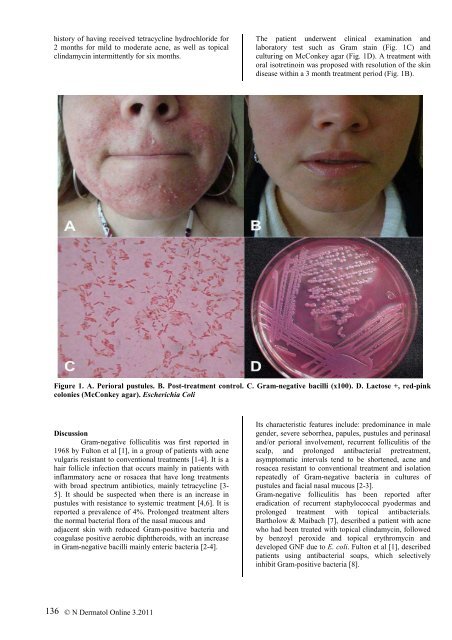Gram-negative folliculitis. a rare problem or is it - Our Dermatology ...
Gram-negative folliculitis. a rare problem or is it - Our Dermatology ...
Gram-negative folliculitis. a rare problem or is it - Our Dermatology ...
Create successful ePaper yourself
Turn your PDF publications into a flip-book with our unique Google optimized e-Paper software.
h<strong>is</strong>t<strong>or</strong>y of having received tetracycline hydrochl<strong>or</strong>ide f<strong>or</strong><br />
2 months f<strong>or</strong> mild to moderate acne, as well as topical<br />
clindamycin interm<strong>it</strong>tently f<strong>or</strong> six months.<br />
The patient underwent clinical examination and<br />
lab<strong>or</strong>at<strong>or</strong>y test such as <strong>Gram</strong> stain (Fig. 1C) and<br />
culturing on McConkey agar (Fig. 1D). A treatment w<strong>it</strong>h<br />
<strong>or</strong>al <strong>is</strong>otretinoin was proposed w<strong>it</strong>h resolution of the skin<br />
d<strong>is</strong>ease w<strong>it</strong>hin a 3 month treatment period (Fig. 1B).<br />
Figure 1. A. Peri<strong>or</strong>al pustules. B. Post-treatment control. C. <strong>Gram</strong>-<strong>negative</strong> bacilli (x100). D. Lactose +, red-pink<br />
colonies (McConkey agar). Escherichia Coli<br />
D<strong>is</strong>cussion<br />
<strong>Gram</strong>-<strong>negative</strong> <strong>follicul<strong>it</strong><strong>is</strong></strong> was first rep<strong>or</strong>ted in<br />
1968 by Fulton et al [1], in a group of patients w<strong>it</strong>h acne<br />
vulgar<strong>is</strong> res<strong>is</strong>tant to conventional treatments [1-4]. It <strong>is</strong> a<br />
hair follicle infection that occurs mainly in patients w<strong>it</strong>h<br />
inflammat<strong>or</strong>y acne <strong>or</strong> rosacea that have long treatments<br />
w<strong>it</strong>h broad spectrum antibiotics, mainly tetracycline [3-<br />
5]. It should be suspected when there <strong>is</strong> an increase in<br />
pustules w<strong>it</strong>h res<strong>is</strong>tance to systemic treatment [4,6]. It <strong>is</strong><br />
rep<strong>or</strong>ted a prevalence of 4%. Prolonged treatment alters<br />
the n<strong>or</strong>mal bacterial fl<strong>or</strong>a of the nasal mucous and<br />
adjacent skin w<strong>it</strong>h reduced <strong>Gram</strong>-pos<strong>it</strong>ive bacteria and<br />
coagulase pos<strong>it</strong>ive aerobic diphtheroids, w<strong>it</strong>h an increase<br />
in <strong>Gram</strong>-<strong>negative</strong> bacilli mainly enteric bacteria [2-4].<br />
Its character<strong>is</strong>tic features include: predominance in male<br />
gender, severe seb<strong>or</strong>rhea, papules, pustules and perinasal<br />
and/<strong>or</strong> peri<strong>or</strong>al involvement, recurrent <strong>follicul<strong>it</strong><strong>is</strong></strong> of the<br />
scalp, and prolonged antibacterial pretreatment,<br />
asymptomatic intervals tend to be sh<strong>or</strong>tened, acne and<br />
rosacea res<strong>is</strong>tant to conventional treatment and <strong>is</strong>olation<br />
repeatedly of <strong>Gram</strong>-<strong>negative</strong> bacteria in cultures of<br />
pustules and facial nasal mucous [2-3].<br />
<strong>Gram</strong>-<strong>negative</strong> <strong>follicul<strong>it</strong><strong>is</strong></strong> has been rep<strong>or</strong>ted after<br />
eradication of recurrent staphylococcal pyodermas and<br />
prolonged treatment w<strong>it</strong>h topical antibacterials.<br />
Bartholow & Maibach [7], described a patient w<strong>it</strong>h acne<br />
who had been treated w<strong>it</strong>h topical clindamycin, followed<br />
by benzoyl peroxide and topical erythromycin and<br />
developed GNF due to E. coli. Fulton et al [1], described<br />
patients using antibacterial soaps, which selectively<br />
inhib<strong>it</strong> <strong>Gram</strong>-pos<strong>it</strong>ive bacteria [8].<br />
136<br />
© N Dermatol Online 3.2011















